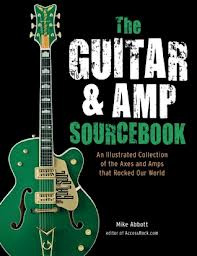
…which should tell you what I think of The Guitar & Amp Sourcebook, now available at a bookstore near you – just in time for Christmas!
And what would Christmas be without Scrooge? Yes, it’s time for my old curmudgeonly self to shine!
As promised in my blog rant of July, 2012, I was going to give this one a chance before pouncing on any harp guitar-related errors or aggravations. Alas, it’s pretty lame.
The good: it’s cheap ($15.15, discounted at you-know-where) and thick – 472 pages. It’s got tons of nice photos (lots of repeats from previous books, but presumably much new), including piles of cool amps from my 60s-70s rock days.
The problem, as always, is that you have to take all the information with a grain of salt. Any of it could be dead-on accurate, or – judging from the harp guitar entries – sloppy and error-prone. Ergo, the whole project is not a reliable reference guide but simply another picture book (author Mike Abbott admitted he is not a researcher or historian).
You’ll recall that I was contacted for photos (with actual $$ offered, a rare thing), but chose not to participate. I had offered my small area of expertise (gratis, as always) and the volunteer proofread that few ever take me up on. This one would have literally taken me just a few minutes to tweak, with everyone happy in the end, I expect.
But do the small errors actually matter? They are admittedly petty complaints. It just continues to gall me that I’ve busted my butt on the Knutsen Archives (as did Dan Most and Tom Noe on the book before me), and even though it’s been up for ten years now, not one guitar book author seems interested in using it. Instead, what Abbott did was use the questionable 16-year old entries from the Tony Bacon Chinery Collection book, along with paraphrasing some of the entertainment essays from Jonathan Kellerman’s book (which I’ll reference as “JK” from here on out).
So, for the record (and only for diehard Dyer/Knutsen researchers and geeks), here are my comments and corrections for the harp guitar entries in The Guitar & Amp Sourcebook:
P. 29: “Circa-1905 Knutsen Harp Guitar”
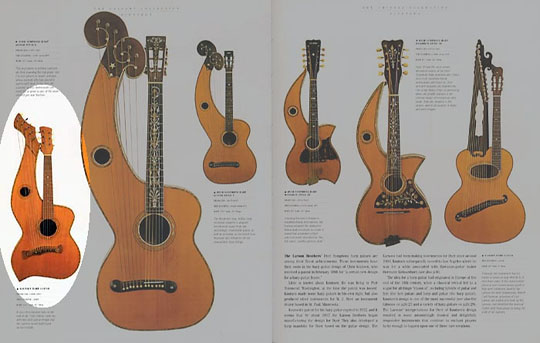
c. 1905 is how it’s listed in the Chinery book (where this photo is from), which at the time was a surprisingly good guess. It’s been c.1911-1913 on my Knutsen site since its inception in 2002. The specimen (Inventory #HGS15) is easy to spot, due to its one non-original black sub-bass tuning knob (which is still there as far as I know, even after traveling from Mandolin Brothers to Chinery to “The Relics Collection” to I forget where now…). More curiously, none of the owners or authors have noticed or mentioned that it’s an obvious short-scale instrument!
However, the unforgivable passage here is the reference to the sub-basses as “drone strings.” Abbott obviously copied this clumsy assumption from Bacon, who referred to them as “sympathetic bass strings” in the Chinery book. How sad that none of these obvious guitar fans have ever taken the time to see and hear a real harp guitarist, let alone read my simple definition of the instrument (which even opens the Wikipedia entry, for cryin’ out loud!). Guys – those sub-basses are notes. Like all those keys on a piano? Yeah, you’re supposed to play them – that’s, uh, why they’re there. (Am I really still explaining this in 2012?)
“1910-1913 Knutsen Harp Mandolin” (not shown)
I apparently wasn’t the only one who didn’t supply photos. Many of these entries were clearly meant to show the JK instruments, and, as none appear, perhaps Jonathan said no as well (which would explain why Abbott asked me for my similar images). Or maybe it was just that the editors/publishers had to put the kibosh on the author’s grandiose plans. The book is already an inch and a quarter thick, and many pages have a single photo with a few other text-only entries. But I know Abbott planned to include photos of all of them for three reasons (too embarrassing): He asked me for photos for all these specific Knutsen entries, then, when I didn’t make them available, the publishers obviously didn’t give him time to adjust his text, which still reads “This (named instrument) is etc, etc,” written as if we’re looking at the accompanying photo, which is oddly missing. I think someone must have even had an early mockup of this original “super guitar book,” as the Dyer Harp Mandolin entry references the Knutsen harp mandolin “featured on page 67.” However, the Knutsen mando isn’t pictured, and it appears not on p.67, but page 29. Oops!
This entry was surely meant to show the JK instrument (from his book’s page 158). Here, Abbott paraphrases JK’s various writings about Knutsen fairly accurately. One hiccup occurs when he states that “The Dyer Company marketed these mandolins, as well as Knutsen’s harp guitars, around 1912.” Dyer never marketed Knutsen’s mandolins, and his harp guitars ten years before (Dyer was definitively done with Knutsen by 1904 if not earlier) – all this is on the site of course.
“Circa-1914 Knutsen Ten-string Harp Guitar” (not shown)
This was also certainly meant to show one of JK’s instruments, the one from his p.162, as his heading is repeated here. I had suspected it was nothing from my site, as I never call these instruments “Harp Guitars”; I call them “convertible harp guitars” or more typically, “Upper Treble Point convertible harp steels” (so collectors and players don’t confuse these predominately-lap instruments with Knutsen’s pure harp guitars). Abbot doesn’t screw up this caption, other than again mentioning “drone strings.”
“1918-20s Knutsen Lap Guitar” (not shown)
JK’s again, from p.176, as the heading matches exactly, as does the gist of the text. I have this dated “1914-1920s,” as JK knows (he chose to tighten up the hypothesized dates for his book, which may or may not be more accurate). Abbott’s entry is fine.
P. 30: “Knutsen Teardrop Guitar” (not shown)
I have no idea what instrument was intended here; it must have been one of those from my own site, which seems odd. The text is simple and generic. Incidentally, all teardrops so far found are c.1914 and later.
“1918-20 Knutsen Pineapple Hawaiian” (not shown)
This was also JK’s (his p.174), corroborated by the description of the bookmatched koa. The “pineapple” designation comes from JK’s text, which came from my Archives terminology. Strangely, Abbott titles it “1918-20” when JK specifically states “1921,” which, believe it or not, is accurate – one of the extremely rare times we have proof of a Knutsen date (from a Knutsen distributor sales receipt!).
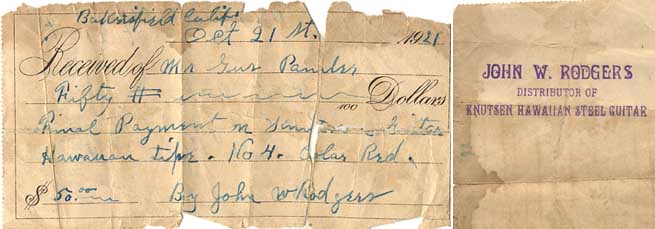
Abbott’s claim that “Later in his career, Knutsen worked with Herman Weissenborn in Los Angeles” is curious. I have no idea where he got this tidbit (not from me or JK). I don’t know of any evidence of a collaboration, though they certainly must have known (and stolen ideas from) each other.
“Circa-1915 Dyer Symphony Harp Mandolin, Style 25” (not shown)
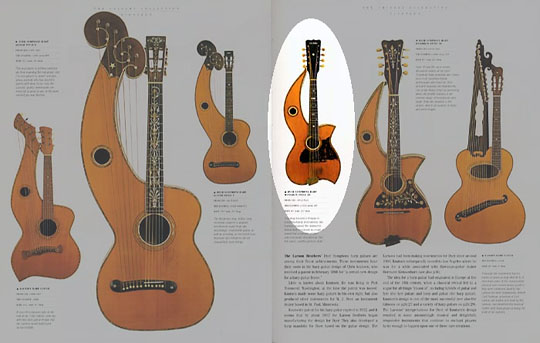
This was undoubtedly meant to include the Chinery book photo, as the date and style match. I’m not sure that “(the Larsons) sold their instruments to the Dyer Company” is the proper way to say “built for Dyer, under an assumed contract.” This entry includes that odd page reference error mentioned above. Again, the original 1996 Chinery/Tony Bacon guess of c.1915 was a good one (I currently have it as 1908 or ‘09).
“Circa-1920s Dyer Harp Guitar”
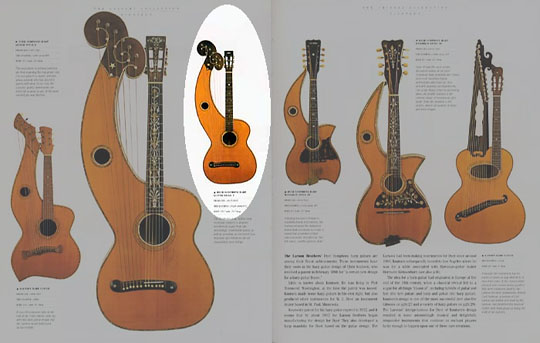
The Style 7 photo from the Chinery/Bacon book is included. The date is theirs as well (again, a reasonable guess, though I now doubt that much was built after 1920, and this serial number would put it at c.1909-1910). In this entry, besides the final dismal “drone strings” reference (well, he’s consistent, at least!), Abbott attempts to paraphrase JK, but screws it up, saying, “European harp guitars of the Victorian age were the inspiration for builders like Gibson, Knutsen, and the Larson brothers.” Yes, presumptuous, isn’t it? JK’s text actually read that the Knutsen hollow arm harp guitar’s horn “recalled the harp guitars popular in Victorian Europe” (italics mine – GM). That is a perfectly reasonable way to say it (assuming we understand what “Victorian Europe – that’s pre-1900 – hollow arm instruments JK was even referring to, and I have no idea). JK simply points out the similarity, Abbott writes as if he knew the minds of Gibson, Knutsen, et al – who may have never even seen any of these (unspecified) European instruments, for all we know.
Sorry to nitpick on Mr. Abbott, and indeed, his minor offenses may be petty. I just get riled up by the fact that this stuff just never ends. I just now heard from another author (who requested an image of my lyre guitar postcard – a “fantasy image” I felt could be shared, as it is already out-of-context). Alas, too late, I pointed him to my entire site and my specific lyre guitar study (which upends all the previous published sloppy organology)…he said the lyre guitar and harp guitar sections had already been written by his “early guitar expert.” Can’t wait for that one.
Meanwhile, I’m still waiting for my friend and colleague Jimmy Westbrook to respond to a lengthy private email to defend or clarify his last book’s many convoluted entries (where guittars and harp-lutes and harp guitars are mixed up every which way). Until then, or maybe just in general, probably just best to avoid that book altogether.
On a more encouraging note, I know these subjects can be presented properly, because Graham McDonald just sent me a draft of his 1000-word Harp Mandolin chapter of his work-in-progress mandolin book, and it’s fantastic. Better than I could possibly do myself (but with fewer jokes). A) He’s done his homework, B) he’s thought it through, C) he gets it, and D) his interpretations and focus and dissemination are logical, understandable and accurate. It certainly didn’t hurt that he used Harpguitars.net for a significant portion of his research, but more to the point, he took the time to absorb and understand it (there is a lot there!). We’ve also chatted a fair amount, in person and via email. Lastly, he was both kind and astute enough to send his draft for review. I made exactly four extremely minor correction/suggestions.
See how simple?

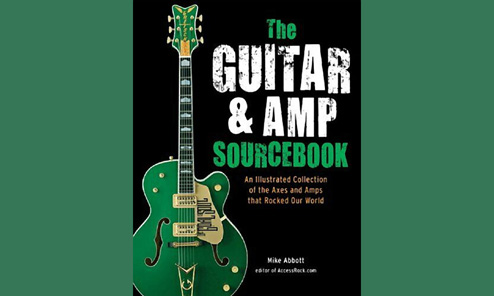
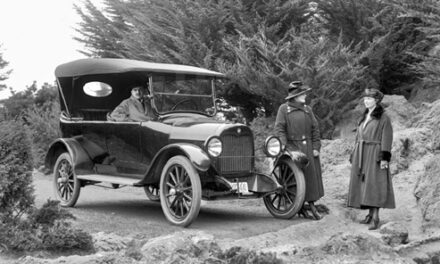
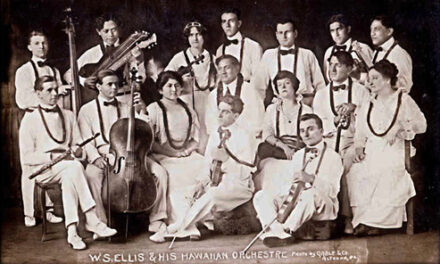
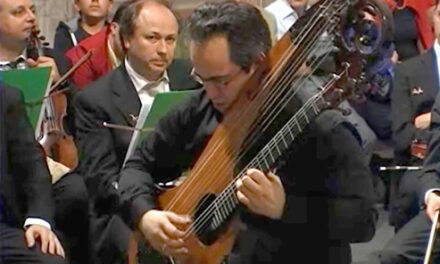
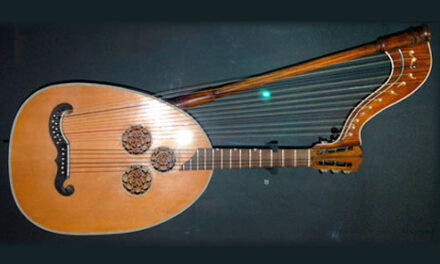
I think the “Knutsen worked for Weissenborn (or vice-versa)” idea came out of a mixture of conjecture and fact found in many sources: This blog, the KA itself, the Noe/Most book, and Ben Elder’s writings on Weissenborn and Kona (which themselves have been paraphrased/stolen/broadcast all over the Net). It’s a lot easier for people to just take someone’s hypothesis and run with it as fact than to actually dig and find out if it’s really true. Or you may find something, and not comprehend how it really fits into the history – e.g., there is a bunch of stuff I’ve found on National that doesn’t fit the “estaablished facts”, and that company was fairly well documented/researched. My point being – there’s a TON of stuff about that era that we just don’t know, and may never know.